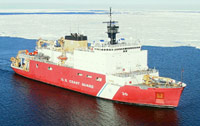Climate Change and the Bering Sea
Scientists studying the effects of climate change on the Bering Sea ecosystem.
Are hard times ahead for the Arctic animals that depend on the Bering Sea for survival? Science writer Karen de Seve joined a research cruise to find out.

June 28, 2006 In this episode, science writer Karen de Seve shares her adventures in the
 Their mission was to gather as much data as possible about the plants and animals in the water. “The main project was looking at what happens to the animals on the bottom as we see the ice recede in the springtime,” said Lee Cooper, one of the chief scientists leading the research cruise entitled, “Climate-driven Changes in Impacts of Benthic Predators in the
Their mission was to gather as much data as possible about the plants and animals in the water. “The main project was looking at what happens to the animals on the bottom as we see the ice recede in the springtime,” said Lee Cooper, one of the chief scientists leading the research cruise entitled, “Climate-driven Changes in Impacts of Benthic Predators in the
Understanding changes in a whole ecosystem, such as the

 Less of a mystery, however, is the food available to the diving birds, walruses, whales and seals in the region. Lovvorn’s team did the first trawls in the
Less of a mystery, however, is the food available to the diving birds, walruses, whales and seals in the region. Lovvorn’s team did the first trawls in the
So what does all of this research tell us about the
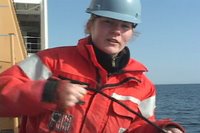
 This time series image show chlorophyll in the Bering Sea during spring bloom in 1994. Black indicates no chlorophyll and red indicates lots of chlorophyll. The algae use chlorophyll to convert sunlight into energy during photosynthesis, so a lot of chlorophyll in the water indicates a lot of plant activity. “We’re really only seeing down to about 20 meters, so light’s not penetrating at certain wavelengths much deeper than that,” said Frey. “The phytoplankton in the ocean grow just like any other plant would; they need nutrients and sunlight. If light’s not penetrating deeper, then the phytoplankton aren’t able to photosynthesize at deeper depths because there’s no sunlight available at those depths. But we do see them at those depths. Basically that’s telling us that phytoplankton are forming at the surface and sinking down through of the water column.”
This time series image show chlorophyll in the Bering Sea during spring bloom in 1994. Black indicates no chlorophyll and red indicates lots of chlorophyll. The algae use chlorophyll to convert sunlight into energy during photosynthesis, so a lot of chlorophyll in the water indicates a lot of plant activity. “We’re really only seeing down to about 20 meters, so light’s not penetrating at certain wavelengths much deeper than that,” said Frey. “The phytoplankton in the ocean grow just like any other plant would; they need nutrients and sunlight. If light’s not penetrating deeper, then the phytoplankton aren’t able to photosynthesize at deeper depths because there’s no sunlight available at those depths. But we do see them at those depths. Basically that’s telling us that phytoplankton are forming at the surface and sinking down through of the water column.”
 diatoms and other tiny plants made of silica, the same chemical in glass.
diatoms and other tiny plants made of silica, the same chemical in glass.
 One of the most dynamic members of the science team was Ruth Cooper, the 11-year-old daughter of chief scientists Jackie Grebmeier and Lee Cooper. Ruth had just finished fifth grade, but she was experiencing the education of a lifetime aboard the Healy. Ruth helped with the stations (see May 25th "Sea of the Midnight Sun" post for details) and counted the brittle stars and other animals that came up in the nets. She also provided much entertainment around the ship.
One of the most dynamic members of the science team was Ruth Cooper, the 11-year-old daughter of chief scientists Jackie Grebmeier and Lee Cooper. Ruth had just finished fifth grade, but she was experiencing the education of a lifetime aboard the Healy. Ruth helped with the stations (see May 25th "Sea of the Midnight Sun" post for details) and counted the brittle stars and other animals that came up in the nets. She also provided much entertainment around the ship.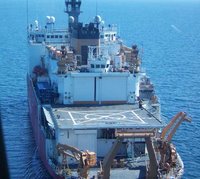
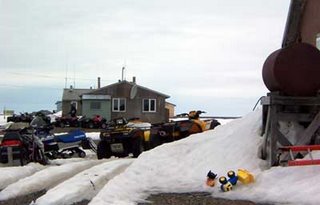

 Dozens of metal fishing boats filled the rocky shore. There were still some snow drifts left near the water, so the boats could easily slide up on the beach. Interspersed between the boats were red splotches of walrus blood where the hunters had disemboweled the small beasts. These were just the young ones. When they kill a walrus cow, the hunters also take the calf because the young ones can't survive alone. The adults are too heavy to bring back whole, so the hunters take out the skull, tusks and meat at sea and leave the carcass on the ice for the sea birds. I stood next to a baby male walrus lying on its back in the snow. Really, it was the skin and meat. All of the other parts had been removed. A woman came over to tell us that every part of the animal would be eaten or used in some way. “That’s the heart,” she said, pointing to a dark red blob. “We eat that. And all that sinew stuff, we eat that, too. Just add a little salt, and it is very tasty.” Next to the entrails was a plastic baggie stuffed full of soft clam bodies. “Those clams are from the walrus’s stomach,” said the woman. “Those are really good. You just clean them off and eat them. Yummy.”
Dozens of metal fishing boats filled the rocky shore. There were still some snow drifts left near the water, so the boats could easily slide up on the beach. Interspersed between the boats were red splotches of walrus blood where the hunters had disemboweled the small beasts. These were just the young ones. When they kill a walrus cow, the hunters also take the calf because the young ones can't survive alone. The adults are too heavy to bring back whole, so the hunters take out the skull, tusks and meat at sea and leave the carcass on the ice for the sea birds. I stood next to a baby male walrus lying on its back in the snow. Really, it was the skin and meat. All of the other parts had been removed. A woman came over to tell us that every part of the animal would be eaten or used in some way. “That’s the heart,” she said, pointing to a dark red blob. “We eat that. And all that sinew stuff, we eat that, too. Just add a little salt, and it is very tasty.” Next to the entrails was a plastic baggie stuffed full of soft clam bodies. “Those clams are from the walrus’s stomach,” said the woman. “Those are really good. You just clean them off and eat them. Yummy.”

 As the bow pointed down the International Dateline, most of the crew and scientists gathered on the bow to watch the Healy smash through the thick pack ice surrounding these two massive rocks jutting out of the Bering Sea. There was much discussion about what day it was on which island. It went something like, "Ok, so it's today over here on the right, but it is tomorrow just over there to the left? So it's basically now and 24 hours from now in the same spot? Wow. That's so weird."
As the bow pointed down the International Dateline, most of the crew and scientists gathered on the bow to watch the Healy smash through the thick pack ice surrounding these two massive rocks jutting out of the Bering Sea. There was much discussion about what day it was on which island. It went something like, "Ok, so it's today over here on the right, but it is tomorrow just over there to the left? So it's basically now and 24 hours from now in the same spot? Wow. That's so weird."
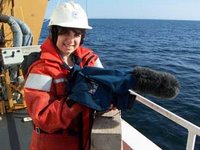 A few minutes later, the ice turned into floes and then disappeared completely as we neared the ship. Jim smoothly landed us on the flight deck and we hauled our gear to our cabins. It wasn’t long after a quick dinner that I jumped donned my videographer hat.
A few minutes later, the ice turned into floes and then disappeared completely as we neared the ship. Jim smoothly landed us on the flight deck and we hauled our gear to our cabins. It wasn’t long after a quick dinner that I jumped donned my videographer hat.
 and late night sun, except from a different direction) was glistening off of the blanket of sea ice covering the Bering Sea, about 30 feet from the Aurora’s front door. The locals tell me this amount of sea ice is pretty normal for May. Last week it snowed in Nome. This week, the high temperature will be in the 50s. That’s also fairly normal for Nome around this time of year, although everyone is calling it a heat wave!
and late night sun, except from a different direction) was glistening off of the blanket of sea ice covering the Bering Sea, about 30 feet from the Aurora’s front door. The locals tell me this amount of sea ice is pretty normal for May. Last week it snowed in Nome. This week, the high temperature will be in the 50s. That’s also fairly normal for Nome around this time of year, although everyone is calling it a heat wave! is north of St. Lawrence Island and well into the northern Bering Sea. Judging by the posted weather reports, the winds have settled down a bit. In early May, Healy faced 42-knot winds. You’d feel that wind hit your face at about 50 miles per hour. Today’s winds blew at a mere 8.6 knots.
is north of St. Lawrence Island and well into the northern Bering Sea. Judging by the posted weather reports, the winds have settled down a bit. In early May, Healy faced 42-knot winds. You’d feel that wind hit your face at about 50 miles per hour. Today’s winds blew at a mere 8.6 knots.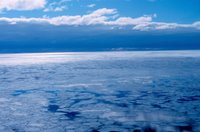 is gathering data to compare against information they collected over the past few years. In March, Jackie, Lee and colleagues published an article in Science that described major shifts in the northern Bering Sea environment. They reported that rising air and ocean temperatures cause sea ice to melt earlier than normal. Melting sea ice has a far-reaching ripple effect, from bottom-dwelling animals to Walruses to native hunters. What's more, the Bering Sea is the main conduit for nutrients flowing north to the Arctic, and it supports the largest fishery in the US. (Photo credit: Michael Van Woert, NOAA NESDIS, ORA)
is gathering data to compare against information they collected over the past few years. In March, Jackie, Lee and colleagues published an article in Science that described major shifts in the northern Bering Sea environment. They reported that rising air and ocean temperatures cause sea ice to melt earlier than normal. Melting sea ice has a far-reaching ripple effect, from bottom-dwelling animals to Walruses to native hunters. What's more, the Bering Sea is the main conduit for nutrients flowing north to the Arctic, and it supports the largest fishery in the US. (Photo credit: Michael Van Woert, NOAA NESDIS, ORA) Here's a view of sea ice off the starboard bow taken by the Healy webcam. Well, I don’t want to give away all of the details yet. Stay tuned ….
Here's a view of sea ice off the starboard bow taken by the Healy webcam. Well, I don’t want to give away all of the details yet. Stay tuned ….
More than 12,000 gold rushers poured into
Check out the online
I'm getting ready to head to the Bering Sea, the icy waters between Alaska and Russia. My destination: a 420-foot-long Coast Guard icebreaker called the Healy. Starting in early May, this ship sailed north from Dutch Harbor, Alaska. The Healy will sail back and forth across a planned route so scientists can study the marine animals in the Bering Sea waters.
